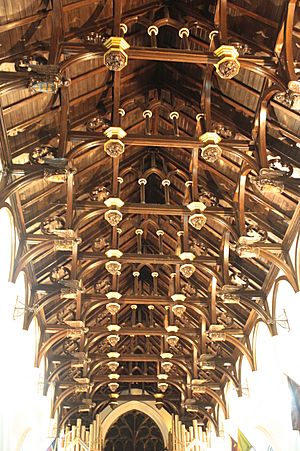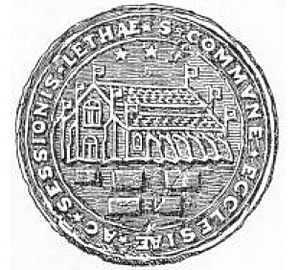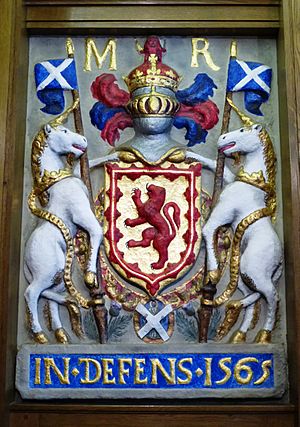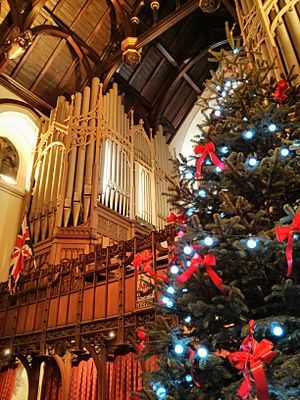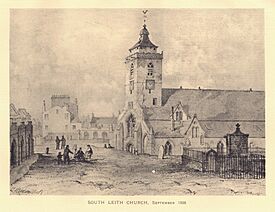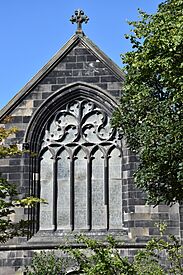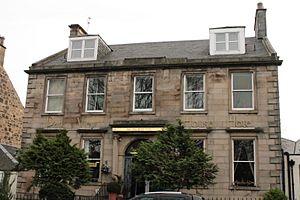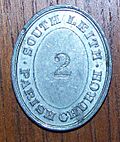South Leith Parish Church facts for kids
Quick facts for kids South Leith Parish Church |
|
|---|---|

The Constitution Street side of the church
|
|
| 55°58′19″N 3°10′22″W / 55.97194°N 3.17278°W | |
| Location | Between Constitution Street and the Kirkgate, near the foot of Leith Walk in Leith, Edinburgh's harbour district |
| Country | Scotland |
| Denomination | Church of Scotland |
| Website | http://www.slpc.co.uk/html/aboutus_church.html |
| History | |
| Former name(s) | St Mary's |
| Status | Church |
| Founded | 1487 |
| Architecture | |
| Functional status | Active |
| Heritage designation | Category A listed |
| Specifications | |
| Capacity | c.1400 |
| Materials | stone |
South Leith Parish Church, once known as the Kirk of Our Lady, St Mary, is a church in Leith, Edinburgh, Scotland. It belongs to the Church of Scotland. This church is the main one in Leith.
Its old churchyard is where famous people are buried. These include John Home, who wrote the play Douglas. Also buried here is John Pew. He was the real person who inspired the character of Blind Pew in Robert Louis Stevenson's book Treasure Island. The church has been fixed up, used for storing ammunition, and rebuilt. But it still looks much like the main part of the original church.
Contents
A Look Back: The Church's History
The church has a very long story, even though most of what you see today is newer. It started as a Roman Catholic chapel (a small church). This chapel was built in 1483 and officially opened in 1487. Before this, South Leith didn't have its own church.
King James III of Scotland gave money to the church when it opened. The first church was quite big. It had a main hall (nave), a special area for the altar (chancel), and parts that crossed over (transepts). The building you see now is a rebuild of just the main hall of the first church. The eastern parts were likely destroyed during a battle in Leith in 1560.
In 1544, the church became a safe place for people. This was during a time of fighting called the Rough Wooing. King Henry VIII of England sent his army to Scotland. He wanted Mary, Queen of Scots, to marry his son. Henry ordered Leith to be burned, so people needed shelter.
The next year, a Protestant leader named George Wishart preached at the church. It's believed that John Knox, another famous Protestant, was there to listen. In 1547, the English army used the church again. This time, they used it as a prison for Scottish nobles.
In 1559, Mary of Guise, who was ruling Scotland at the time, worshipped here. Her family symbol is still in the church entrance. Mary had built a wall around Leith and had her palace there. Thousands of French soldiers guarded it.
The Siege of Leith
In 1560, the English army and navy came to Leith. They were invited by Scottish Protestant leaders. Their goal was to make the French soldiers leave. This event was called the Siege of Leith. The church was hit by English cannons. This is probably when the eastern parts of the church were destroyed.
Both French and English troops left Leith after the Treaty of Edinburgh. This treaty was meant to bring peace. After this peace, big changes happened for the church. The nearby Restalrig Church had been the main church for the area. But it was torn down by order of the new General Assembly of the Church of Scotland. South Leith Church, even though it was damaged, became the new main church for the area.
The way people worshipped also changed. It went from Roman Catholic to Presbyterian, because of the Scottish Reformation. The church was led by David Lindsay, who later became a bishop.
It took some time for the new system to work smoothly. In 1571, there were many talks about who should get church jobs. Some noblemen became bishops without proper training. Also, some church jobs were given to people who were still too young. In 1572, a special meeting was held at the church. They made decisions, but they weren't fully put into action. This was because the King, James VI of Scotland, was still a child.
On May 1, 1590, King James VI and his wife, Anne of Denmark, arrived in Leith. After a welcome speech, Anne stayed at a building called the King's Wark. James went alone to hear a sermon at the Parish Kirk.
The church's new role as the main Parish church was made official by Parliament in 1609. The church records, which still exist, go back to May 1597. A seal from 1608 shows the church looking much like it does today. In 1615, a central steeple (a tall, pointed tower) was added to the church.
In the mid-1600s, the church helped with health measures. It also helped people suffering during the Plague of 1645. Over 2,700 people died, which was half the population of Leith. From 1650 to 1657, soldiers used the church to store ammunition. The church records show how hard it was to hold services then.
From 1687 to 1692, the church showed its commitment to Presbyterianism. It removed members who followed the Episcopalian way of worship.
18th and 19th Centuries
In 1766, Henry Hunter became the new minister. He later published sermons and translated works by French scientists.
From 1824 to 1843, Rev James Grant was the minister. He became famous as the longest-serving Director of Scottish Widows. In 1836, the central steeple that had been there since 1615 was taken down. It was leaning because the newer walls had sunk.
The Disruption of 1843 caused some people to leave the church. But the church recovered. It was rebuilt and restored from 1847 to 1848. The architect was Thomas Hamilton. The main shape of the old church was kept. The lower parts of the walls are original.
A new square tower was built at the northwest. Inside, there is a beautiful hammerbeam roof in the main hall. It is said to be like the one in St Isaac's in St Petersburg. The church is now a Category A listed building.
The rebuilding was criticized at the time and later. Some felt that the architects didn't respect the old building enough. They wished it had been left alone until people understood church restoration better.
In 1915, over 200 soldiers died in a train crash. This was the Quintinshill rail disaster in Gretna. These soldiers were from Leith and nearby towns. Their battalion's flags are kept at the church to remember them. The soldiers are buried in Rosebank Cemetery.
Where is the Church?
South Leith Parish Kirk is on the Kirkgate, Leith, which is now a street for walking. It is in a parish (church area) that is shaped like a triangle. It borders other historic parishes and the Firth of Forth. The area used to be about 2,200 acres. But over time, new parishes were created as the population grew.
The church is home to the 10th Leith Boys Brigade Company and the Girl Guides. They meet in the church halls on Henderson Street.
The Manse
The original manse (the minister's house) was probably on the Kirkgate, but its exact spot is not known. A new manse was built in 1820 at Hermitage Place. This old manse still stands but is now a hotel. The current manse is on Claremont Road, further east.
Memorials
The churchyard is where many people are buried. These include the playwright John Home and John Pew. Robert Louis Stevenson, who wrote Treasure Island, is said to have based his character Blind Pew on this John Pew. Pew was a maltman (someone who makes malt) and was said to have 25 children! Stevenson was related to the Balfour family, so he might have seen Pew's grave.
Other notable people buried here include Adam White, Leith's first leader, and Hugo Arnot, a historian. The poet Robert Gilfillan is also buried nearby.
Inside the church, there are memorials to:
- Very Rev Dr James Mitchell
- Very Rev Dr John White
- Sir Malcolm Smith
- William Lindsay (shipowner)
- James Reoch, a leader of Leith
Church Leaders
The current Minister is the Rev Iain May. He started his role on April 18, 2012.
See also
|


